The Hephthalites, sometimes called the White Huns, were a people who lived in Central Asia during the 5th to 8th centuries CE, part of the larger group of Eastern Iranian Huns. They formed an empire, the Imperial Hephthalites, and were militarily important from 450 CE, when they defeated the Kidarites, to 560 CE, when combined forces from the First Turkic Khaganate and the Sasanian Empire defeated them. After 560 CE, they established "principalities" in the area of Tokharistan, under the suzerainty of the Western Turks and of the Sasanian Empire, before the Tokhara Yabghus took over in 625.
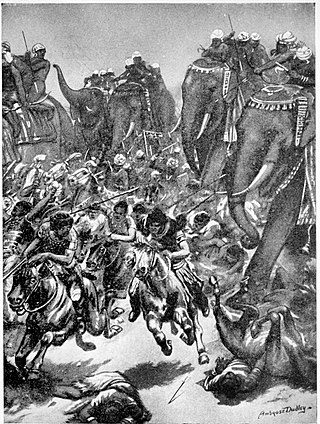
Yashodharman was ruler of the Malava Empire in North India, from 515 until his death in 545. He belonged to the Second Aulikara dynasty. He conquered much of the Indian subcontinent between c. 530–540 according to the Mandsaur pillar inscription.

Rājataraṅgiṇī is a metrical legendary and historical chronicle of the north-western part of Indian sub-continent, particularly the kings of Kashmir. It was written in Sanskrit by Kashmiri historian Kalhana in the 12th century CE.

Xionites, Chionites, or Chionitae were a nomadic people in the Central Asian regions of Transoxiana and Bactria.
The Kidarites, or Kidara Huns, were a dynasty that ruled Bactria and adjoining parts of Central Asia and South Asia in the 4th and 5th centuries. The Kidarites belonged to a complex of peoples known collectively in India as the Huna, and in Europe as the Chionites, and may even be considered as identical to the Chionites. The 5th century Byzantine historian Priscus called them Kidarite Huns, or "Huns who are Kidarites". The Huna/Xionite tribes are often linked, albeit controversially, to the Huns who invaded Eastern Europe during a similar period. They are entirely different from the Hephthalites, who replaced them about a century later.

Buddhism was an important part of the classical Kashmiri culture, as is reflected in the Nilamata Purana and Kalhana's Rajatarangini. Buddhism is generally believed to have become dominant in Kashmir in the time of Emperor Ashoka, although it was widespread there long before his time, enjoying the patronage not only of Buddhist rulers but of Hindu rulers too. From Kashmir, it spread to the neighbouring Ladakh, Tibet and China proper. Accounts of patronage of Buddhism by the rulers of Kashmir are found in the Rajatarangini and also in the accounts of three Chinese visitors to Kashmir during 630-760 AD.
Daradas were an ancient people who lived north and north-west to the Kashmir Valley. This kingdom is identified to be the Gilgit region, in the Gilgit-Baltistan region along the river Sindhu or Indus. They are often spoken along with the Kambojas. The Pandava hero Arjuna had visited this country of Daradas during his northern military campaign to collect tribute for Yudhishthira's Rajasuya sacrifice. The country of Darada has also been mentioned in the Rasa Ratna Samucchaya, a book dealing about Rasasastra
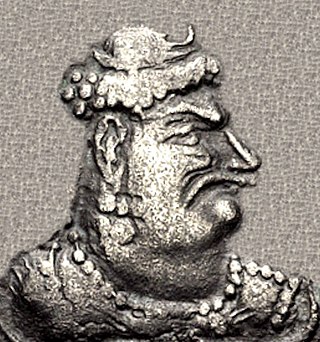
Mihirakula, sometimes referred to as Mihiragula or Mahiragula, was the second and last Alchon Hun king of northwestern region of the Indian subcontinent between 502 and 530 CE. He was a son of and successor to Toramana of Huna heritage. His father ruled the Indian part of the Hephthalite Empire. Mihirakula ruled from his capital of Sagala.

Toramana also called Toramana Shahi Jauvla was a king of the Alchon Huns who ruled in northern India in the late 5th and the early 6th century CE. Toramana consolidated the Alchon power in Punjab, and conquered northern and central India including Eran in Madhya Pradesh. Toramana used the title "Great King of Kings", equivalent to "Emperor", in his inscriptions, such as the Eran boar inscription.

NarasimhaguptaBaladitya was the Gupta Emperor from 495 to 530 CE. He was son of Purugupta and probably the successor of Budhagupta.
Hunas or Huna was the name given by the ancient Indians to a group of Central Asian tribes who, via the Khyber Pass, entered the Indian subcontinent at the end of the 5th or early 6th century. The Hunas occupied areas as far south as Eran and Kausambi, greatly weakening the Gupta Empire. The Hunas were ultimately defeated by a coalition of Indian princes that included an Indian king Yasodharman and the Gupta emperor, Narasimhagupta. They defeated a Huna army and their ruler Mihirakula in 528 CE and drove them out of India. The Guptas are thought to have played only a minor role in this campaign.
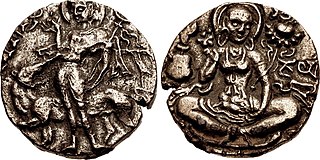
Meghavahana was ruler and founder of second Gonanda dynasty of Kashmir during middle of first millennium CE. Meghavahana was 80th ruler of the Gonanda line of rulers, he was followed by 81st ruler Pravarasena.
The Karkota dynasty ruled over the Kashmir valley and some northern parts of the Indian subcontinent during 7th and 8th centuries. Their rule saw a period of political expansion, economic prosperity and emergence of Kashmir as a centre of culture and scholarship.
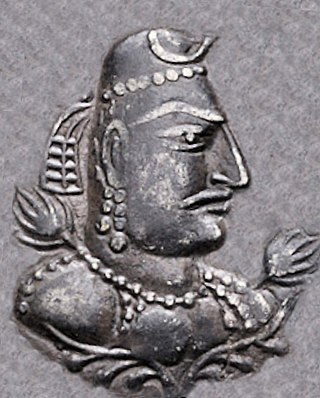
The Alchon Huns, also known as the Alkhan, Alchono, Alxon, Alkhon, Alakhana, and Walxon, were a nomadic people who established states in Central Asia and South Asia during the 4th and 6th centuries CE. They were first mentioned as being located in Paropamisus, and later expanded south-east, into the Punjab and Central India, as far as Eran and Kausambi. The Alchon invasion of the Indian subcontinent eradicated the Kidarite Huns who had preceded them by about a century, and contributed to the fall of the Gupta Empire, in a sense bringing an end to Classical India.
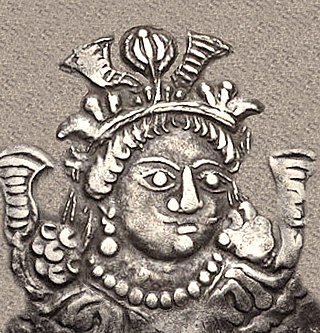
Kidara I fl. 350–390 CE) was the first major ruler of the Kidarite Kingdom, which replaced the Indo-Sasanians in northwestern India, in the areas of Kushanshahr, Gandhara, Kashmir and Punjab.
The Second Gonanda dynasty, was a Kashmiri Hindu dynasty. According to Kalhana, this dynasty ruled Kashmir just before the Karkotas.

Sri Pravarasena, also sometimes Pravarasena II based on the regnal lists of the Rajatarangini, was a 6th-century Huna king of the Alchon Huns in the area of Gandhara and Kashmir in northwestern India. His reign probably lasted about 60 years from about the year 530 CE.

The Hephthalite silver bowl is a bowl discovered in the Swat region of Gandhara, Pakistan, and now in the British Museum. It dates from 460 to 479 CE, and the images represent two different Huna tribes, suggesting a period of peaceful coexistence between the Kidarites and the Alchons.
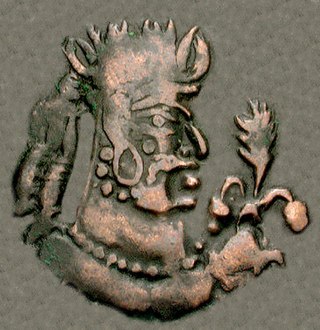
Toramana II was a ruler of the Alchon Huns in the 6th century CE.

Toramana of Kashmir, was a ruler of Kashmir in the 6-7th century CE. This ruler has often been called "Toramana II" in numismatic studies, but this name now tends to be used for an earlier Alchon Hun ruler of Kabulistan: Toramana II.














